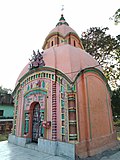Jalshara
Jalsara | |
|---|---|
Village | |
| Coordinates: 22°40′54″N 87°39′51″E / 22.681634°N 87.664091°E | |
| Country | |
| State | West Bengal |
| District | Paschim Medinipur |
| Population (2011) | |
| • Total | 2,183 |
| Languages | |
| • Official | Bengali, English |
| Time zone | UTC+5:30 (IST) |
| PIN | 721212 |
| Telephone/STD code | 03225 |
| Lok Sabha constituency | Ghatal |
| Vidhan Sabha constituency | Ghatal |
| Website | paschimmedinipur |
Jalsara is a village in the Ghatal CD block in the Ghatal subdivision of the Paschim Medinipur district in the state of West Bengal, India.
Geography[edit]


5miles
M: municipal city/ town, R: rural/ urban centre, H: historical/ religious centre
Owing to space constraints in the small map, the actual locations in a larger map may vary slightly
Area overview[edit]
Ishwar Chandra Vidyasagar, scholar, social reformer and a key figure of the Bengal Renaissance, was born at Birsingha on 26 September 1820.[1][2]
Ghatal subdivision, shown in the map alongside, has alluvial soils. Around 85% of the total cultivated area is cropped more than once.[3] It has a density of population of 1,099 per km2, but being a small subdivision only a little over a fifth of the people in the district reside in this subdivision. 14.33% of the population lives in urban areas and 86.67% lives in the rural areas.[4]
Note: The map alongside presents some of the notable locations in the subdivision. All places marked in the map are linked in the larger full screen map.
Demographics[edit]
According to the 2011 Census of India, Jalsara had a total population of 2,183, of which 1,118 (51%) were males and 1,065 (49%) were females. There were 252 persons in the age range of 0–6 years. The total number of literate persons in Jalshhara was 1,378 (71.36% of the population over 6 years).[5]
Education[edit]
Jalsara R.K.High School is a Bengali-medium coeducational institution established in 1960. The school has facilities for teaching from class V to class XII. It has a library with 135 books, 9 computers and a playground.[6]
Culture[edit]
David J. McCutchion mentions the Siva temple at Jalsara as a high-towered baro-chala with ratha projections. It is largely plain and measures 13’ square.[7]
Jalsara picture gallery[edit]
-
Baro-chala Buro Shiva temple
-
Buro Shiva temple
References[edit]
- ^ Murshid, Ghulam. "Vidyasagar, Pundit Iswar Chandra". Banglapedia. Retrieved 24 July 2016.
- ^ "Ishwar Chandra Vidyasagar". www.whereincity.com. Archived from the original on 25 December 2018. Retrieved 24 July 2016.
- ^ "District Human Development Report Paschim Medinipur, 2011". Department of Planning and Statistics, Government of West Bengal. pp. 27–28. Retrieved 10 September 2020.
- ^ "District Statistical Handbook Paschim Medinipur, 2013". Table 2.2, 2.4 (a). Department of Planning and Statistics. Retrieved 10 September 2020.
- ^ "CD block Wise Primary Census Abstract Data(PCA)". West Bengal – District-wise CD blocks. Registrar General and Census, India. Retrieved 25 August 2020.
- ^ "Jalshar R.K. High School U. Pry". Schools.org. Retrieved 25 August 2020.
- ^ McCutchion, David J., Late Mediaeval Temples of Bengal, first published 1972, reprinted 2017, page 40. The Asiatic Society, Kolkata, ISBN 978-93-81574-65-2





